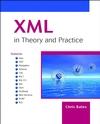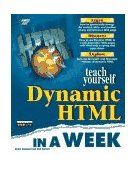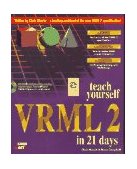
XML in Theory and Practice
I performed the technical review for Chris Bates' book on all things XML. The book is appropriate for a beginning XML enthusiast who has a strong background in Information Systems and Web Enablement. John Wiley Europe published the book as ISBN 0-470-84344-6.
Teach Yourself Dynamic HTML in 7 Days

I am the primary author of this title published by Sam's Net. Rick Darnell is the co-author. Rick and I worked hard to be first to market with a self-help book on the emerging HTML 4 specification. Both Netscape's and Microsoft's approach to interactive Web page development are covered with respect to their latest version 4.0 web browsers. The Teach Yourself series is especially successful and this book follows the traditional recipe closely. The book comes complete with the HTML specification as well as explanations, examples, Q&A, quizzes and workshops. The book ISBN is 1-57521-335-4 and is available in soft cover, about two inches thick.
Teach Yourself VRML 2 in 21 Days
 Book source code available here.
Book source code available here.
I am co-author of this title published by Sam's Net. Chris Marrin is the primary author. Chris worked for Silicon Graphics at the time and was responsible along with two others for the Moving Worlds VRML 2 proposal. Chris now works for Sony on their TV set top box project and is active in the EAI Working Group of the Web 3D Consortium. The 21 Days series is especially successful and this book follows the teach yourself recipe closely. The complete VRML 2 specification is covered with explanations, examples, Q&A, and exercises. The International Standards Book Number is 1-57521-193-9 and is available in soft cover, about two inches thick.
Personal Connection to the Ocean Via On-line Interactive Experiences
Campbell, B. D., Mott, B., "Personal Connection to the Ocean Via On-line Interactive Experiences", In Proceedings of the 7th International Aquarium Congress, Shanghai, China (Oct 19-24, 2008). (PDF)Emergency Response Planning and Training through Interactive Simulation and Visualization with Decision Support
B. Campbell, O. Mete, T. Furness, S. Weghorst, Z. Zabinsky, "Emergency Response Planning and Training through Interactive Simulation and Visualization with Decision Support", 2008 IEEE International Conference on Technologies for Homeland Security (May 2008). (PDF)Effects of landuse change on the hydrologic regime of the Mae Chaem river basin
Thanapakpawin, P., Richey, J., Thomas, D., Rodda, S., Campbell, B., Logsdon, M. Effects of landuse change on the hydrologic regime of the Mae Chaem river basin, NW Thailand, Journal of Hydrology 334:2, pp. 215-230 (February 2007). (PDF)An Occlusion-Capable Optical See-through Head Mount Display for Supporting Co-located Collaboration
Kiyokawa, K.; Billinghurst, M.; Campbell, B.; Woods, Eric.; (2003). To appear in the Proceedings of the International Symposium on Mixed and Augmented Reality, Tokyo, Japan (October 2003). Illustrates the design and advantages of an occlusion-capable head mount as demonstrated at SIGGRAPH 2002 in San Antonio, Texas. (PDF).Web3D in Ocean Science Learning Environments: Virtual Big Beef Creek
I presented this paper (HTML) ( PDF) about informal science learning in a virtual environment based on the Big Beef watershed at the 2002 Web3D Symposium in Tempe, AZ (Feb 24-28, 2002) on behalf of the authors: Campbell, B., Collins, P., Hadaway, H., Hedley, N. and Stoermer, M. In Proceedings of the 2002 Web3D Symposium, pp. 85-91.Magic Book Flora
I wrote a paper supporting the motivation behind my Boston CyberArts Festival Exhibit which ran April 21-May 6, 2001. The paper is entitled Distributing 3-D Content Through Genomes and Evolutionary Process: A Focus on Plants. Boston CyberArts Festival : Boston, MA (2001).The Virtual Anatomy Lab: A Hands-on Anatomy Learning Environment
I presented a poster on The Virtual Anatomy Lab: A Hands-on Anatomy Learning Environment at MMVR2001:Campbell, B.; Rosse, C.; Brinkley, J.F.; (2001). Proceedings of the Medicine Meets Virtual Reality (MMVR2001) Conference. (PDF)
Virtual Playground: Architectures for a Shared Virtual World.
I presented a paper called Virtual Playground: Architectures for a Shared Virtual World (PDF) at ACM Proceedings of the Virtual Reality Software and Technology (VRST '98) Conference on November 2, 1998. I represented the following team: Schwartz, P., Bricker, L.,Campbell, B., Furness, T., Inkpen, K., Matheson, L., Nakamura, N., Shen, L., Tanney, S., and Yen, S.VRML Developer's Journal
I have an article about creating a Kaleidoscope using VRML's External Authoring Interface in the first issue of the first volume of the Virtual Reality Developer's Journal as well as the August 1998 Java Developer's Journal.The second issue of the VRDJ was never published. My submission focused on using the VRML 97 PROTO node to create group projects in VRML. Check out my suggestions for a Worldwide Kaleidoscope Project. Feel free to submit a Kaliedoscope piece to me. If I get enough, I will put a dynamic Kaleidoscope generator on the Web and let you know about it.
I had hoped to contribute regularly to the first ever magazine devoted entirely to VRML development.